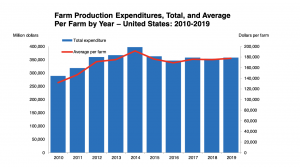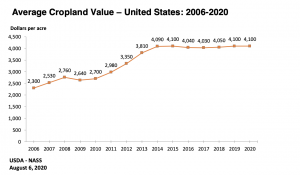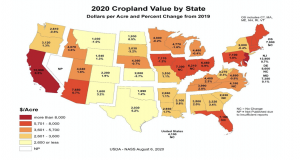Farm Bankruptcies, Drought, Derecho, and Land Values-Recent Ag Econ Variables in Focus
Wall Street Journal writer Jesse Newman reported last week that, “More U.S. farmers are filing for bankruptcy, as federal payments projected to reach record levels this year fall short of compensating for the coronavirus pandemic and a yearslong slump in the agricultural economy.

“About 580 farmers filed for chapter 12 bankruptcy protection in the 12-month period ended June 30, according to federal data. That was 8% more than a year earlier, though bankruptcies slowed slightly in the first half of 2020 partly because of an infusion of federal aid and hurdles to filing during the pandemic, according to agricultural economists and attorneys.
The pandemic has pressured prices for many commodities, squeezing farmers who raise crops and livestock, and prolonging a six-year downturn in the Farm Belt.
The Journal article noted that, “The Trump administration is expected to dole out a record $33 billion in payments to farmers this year, according to the University of Missouri’s Food and Agricultural Policy Research Institute. The funds, including those intended to help farmers hurt by trade conflicts and the coronavirus, would push government payments to 36% of farm income, the highest share in nearly two decades, the institute said.”
“Chapter 12 bankruptcy, created during the 1980s farm crisis, allows distressed family farmers or fishermen to devise a plan to repay creditors over three to five years. Farms with debts that don’t exceed $10 million may file for the protection,” the Journal article said.
Ms. Newman added that, “Trouble for many farmers extends back to a commodity boom beginning in 2006 that encouraged them to borrow heavily, said Patrick Westhoff, director of the Food and Agricultural Policy Research Institute.
“U.S. farm debt has grown steadily since then to more than $425 billion this year, the U.S. Department of Agriculture estimates. That is the largest sum since a farm crisis in the 1980s that pushed many farmers and lenders out of business.”
Meanwhile, Reuters writer Mark Weinraub reported this week that, “Farmers routinely make changes to their acreage intentions as the calendar advances, substituting in different crops if the weather mucks up their original plans. But leaving the ground bare is new territory for U.S. farmers who typically plant fencerow to fencerow, trying to squeeze profit out of every available acre.
“The most recent acreage data from the government showed corn and cotton plantings in particular were far below initial expectations, with corn seedings in June dropping the most from March in 37 years.
The coronavirus pandemic caused many farmers to give up on their corn crop before it was even in the ground. When calculating their plans for 2020, they had viewed corn as the crop most likely to turn a profit as ongoing tensions with China threatened to roil the soybean export program even after Beijing and Washington inked a Phase 1 trade deal in January.
The Reuters article pointed out that, “A shift in government subsidies also may have contributed to farmers’ decision to leave some fields fallow.
“Coronavirus aid payments were based on farmers’ year-earlier output, a change from the Trump administration’s trade aid program meant to compensate farmers for lost sales to China. Those payments, based on planted acreage in both 2018 and 2019, encouraged growers to get crops in the field even when market prices did not support planting.”
In other developments, Donnelle Eller reported on the front page of Friday’s Des Moines Register that, “All together, 23 counties in west-central Iowa, including Polk, Dallas and Madison in metro Des Moines, are experiencing extreme or severe drought, according to the U.S. Drought Monitor, which is updated weekly.

“The deepening drought is cutting the area’s corn yields and threatening to curb the soybean harvest; burning up pastures and lawns; and requiring some livestock producers to truck water to animals in cases where ponds and creeks are drying up.”
The Register article noted that, “Precipitation in Iowa’s west-central counties is 8-12 inches below normal, said state climatologist Justin Glisan.”
And on Monday, Associated Press writers Ryan J. Foley and Seth Borenstein reported that, “A rare storm packing 100 mph winds and with power similar to an inland hurricane swept across the Midwest on Monday, blowing over trees, flipping vehicles, causing widespread property damage and leaving hundreds of thousands without power as it moved through Chicago and into Indiana and Michigan.”
Donnelle Eller reported in Wednesday’s Des Moines Register that,
Across Iowa, the storm hit about 10 million acres of crops, Gov. Kim Reynolds said Tuesday during a news conference. The Iowa Department of Agriculture said the storm affected roughly a third of the state, which grows about 32 million acres of corn, soybeans and other crops.
The Register article noted that, “The storm, with straight-line winds nearing 100 mph, pummeled homes, farms and businesses across dozens of counties in central Iowa. In addition to crops, it destroyed grain bins, machine sheds, barns and livestock buildings.”
“Joining [Justin Glisan, the Iowa state meteorologist] on a call with reporters was Iowa Agriculture Secretary Mike Naig, who said elevators in the state have lost storage for ‘tens of millions of bushels‘ and that the capacity farmers lost amounts to millions of bushels more,” the Register article said.
DTN Ag Policy Editor Chris Clayton reported on Tuesday that, “With USDA this week expected to forecast a large U.S. corn crop this fall, it’s unlikely the market will acknowledge much crop loss from the storm, though there were also social media images of flattened corn and soybean fields.”
Reuters writers P.J. Huffstutter and Christopher Walljasper reported on Monday that, “It toppled grain bins in dozens of counties and tore into livestock farms in Iowa, the nation’s top hog and corn producer. Bin losses, ahead of this fall’s harvest, could leave some farmers scrambling to find storage for their crops, said agronomists.”
With respect to recent government reports regarding the U.S. ag economy, the USDA’s National Agricultural Statistics Service (NASS) noted late last month in its Farm Production Expenditures Annual Summary that, “Farm production expenditures in the United States are estimated at $357.8 billion for 2019, up from $354.0 billion in 2018. The 2019 total farm production expenditures are up 1.1 percent compared with 2018 total farm production expenditures.”

And earlier this month, in its annual Agricultural Land Values report, NASS indicated that, “The United States cropland value averaged $4,100 per acre, no change from the previous year.”


Also with respect to farmland values, a news release last month from Purdue University stated that, “The 2020 Purdue Farmland Value and Cash Rents Survey suggests that farmland prices across Indiana improved since the June 2019 survey; however, many of those gains occurred between June and December 2019. Since then farmland prices have declined modestly.”
Source: Keith Good, Farm Policy News
